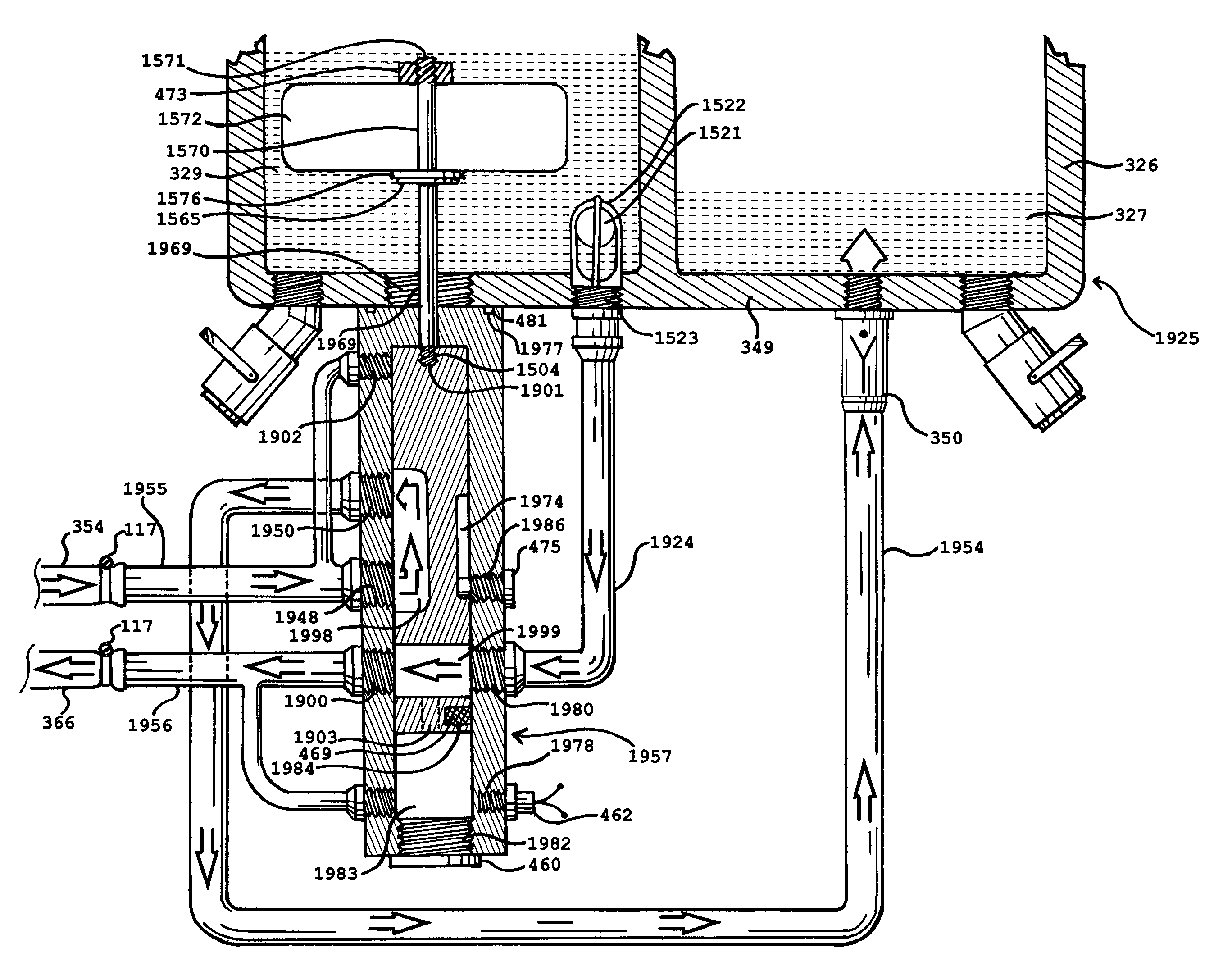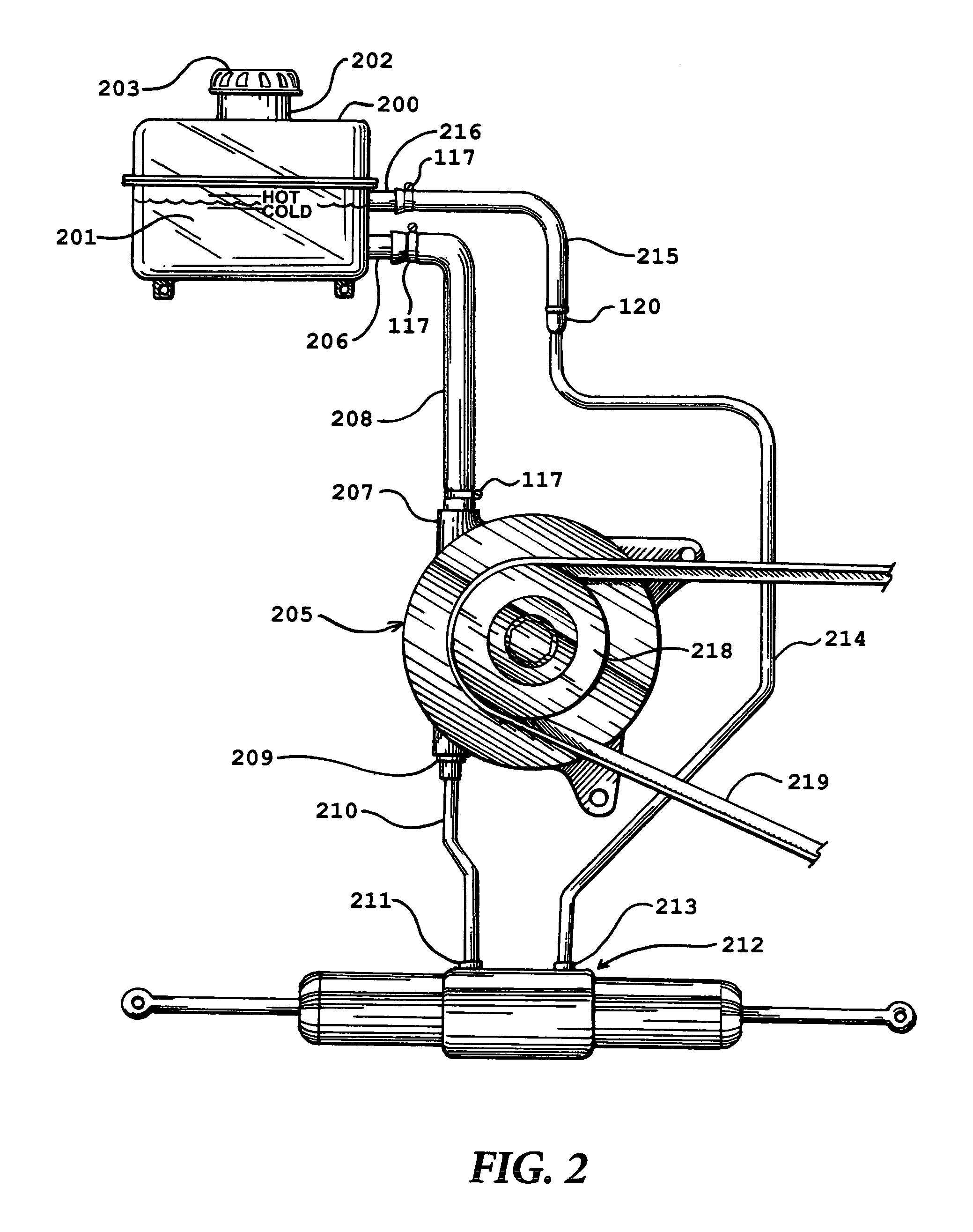A significant drawback of this type of unit is the need to connect the unit to the vehicle's electrical system.
Another drawback is its concurrent mixing of fresh fluid with contaminated used fluid in the power steering reservoir right before it is delivered to the low pressure port of the power steering pump.
This tends to result in an incomplete fluid exchange typically characterized by a correspondingly lower proportion of fresh fluid exchanged for the used fluid in the circuit, compared to the second category of power steering fluid exchange units which are much more expensive and, if used properly, typically exchange a higher percentage of the used fluid for fresh.
Therefore, the units of the first category, best described as “mixing type” units are only minimally effective and of limited suitability for periodic fluid exchange maintenance of power steering systems when compared to larger, more expensive units.
However, their higher price is a drawback which can make them less available to vehicular service centers with limited funds for service equipment acquisitions.
An additional drawback is that units of this second category tend to be significantly larger, heavier, less portable and therefore less convenient to operate than the smaller, compact and much less expensive units described above to be in the first category.
The need for a power steering fluid exchanger to have its own onboard pump adds significantly to the cost of the unit.
Power steering system fluid exchange units based on this principal are typically expensive not only because of the size of the case required, but their complexity makes the cost of manufacturing an exchanger with a positive displacement fresh fluid pump which harnesses the power of the power steering pump quite substantial.
The devices of this second category, the larger more expensive units that actually exchange fluid without just mixing it in the power steering reservoir, are expensive to manufacture because they require costly electric solenoid operated valves which need electrical power.
First, having to make connection to vehicle's battery requires the use of connection wires which can make contact with moving parts in the engine compartment if wrongly positioned or moved during the fluid exchange.
Second, many currently manufactured vehicles have sophisticated onboard diagnostic computer systems (OBD systems) which can sense voltage changes, voltage spikes, and anomalies in the vehicle's electric system and which will then record a fault code.
It is expected that these advanced OBD systems may be increasingly sensitive to unnecessary, non-operational current fluctuations, which may cause false error codes or cause the vehicle to assume a default mode of operation which lowers the gas mileage of the vehicle until the computer system is reset, which typically requires the vehicle to be driven for a period of time.
If these expected voltage increases are implemented service equipment which has been manufactured for 12 volts direct current (DC) will become obsolete and unusable unless it is modified to accept these higher voltages.
If it has to be modified or replaced this will be an added and undesirable expense.
The need for access to shop air can limit the service area used to provide the fluid exchange.
This particular unit is somewhat bulky and cumbersome to use, and due to the multiple steps involved, takes an unnecessarily long time to operate.
In addition it seems likely that the use of such a flushing procedure without the power steering pump operative would not be as effective in removing all the used fluid as would a fluid exchange procedure accomplished with the power steering pump operative.
These drawbacks prevent it from being a preferred option for those service centers who want a unit that is compact, self contained with no need for compressed shop air or connection to a source of electrical power, simple to operate and capable of exchanging a high proportion of used fluid for fresh fluid in a relatively short period of time while the power steering pump is operative.
Installing this valve as depicted for routine power steering fluid exchanges would be somewhat difficult task in and of itself due to the tendency for the power steering pump's high pressure conduit (or hose) to have connections which are often be corroded and typically somewhat difficult to reach and disconnect.
However, the suggested positioning at which the valve is connected as apparently disclosed in Graham's patent is downstream from the pump's outlet port, and therefore it is assumed that the power steering system must be inoperative while a new fluid fill or a fluid exchange is instituted, since operating the pump with the valve downstream would obstruct the output flow of the pump and perhaps could damage the power steering pump if it's relief valve was malfunctioning or its setting was too high.
It appears then that use of this valve and method would be too slow and unduly cumbersome to be practical for use at most vehicle service centers as a regular power steering maintenance procedure.
The patent discloses that air entrained in a power steering system may cause unwanted noise and / or vibration which may be annoying to the driver who first operates the vehicle after the filling of the power steering system.
The patent does not disclose using the power steering pump's low pressure inlet port side or its positive pressure outlet side for powering the pumping of fluid into and through the power steering system redundantly, even though the engine is running to render the power steering pump operative.
The method does not disclose or teach the exchange of used fluid for fresh fluid and is apparently limited to charging a power steering system for the first time while removing the air that inevitably becomes entrained.
First, the patent depicts the fluid supply port at the bottom of the bulk holding tank to be at a level below that of the connector assembly, and the negative pressure provided by the power steering pump is not likely to be great enough to pump the fluid from the bulk holding tank without assistance by an auxiliary pump.
Second, the low pressure provided by the vacuum pump will likely conflict with the low pressure provided by the power steering pump which would inhibit the flow of the fresh fluid into the conduit supplying the power steering pump.
One potential drawback to the use of this method of filling a new power steering system with fresh fluid for the first time is that the flow charge pump must have a delivery output pressure great enough to overcome the low pressure provided by the vacuum pump but not so great as to deliver fluid at a greater flow rate to the reservoir than the power steering pump will accept it.
If this occurs pressure can build up inside the reservoir which can disrupt the sealing of the connector into the reservoir filler neck and perhaps can cause leakage of fluid and displacement of the connector up and out of position in the filler neck.
The Brown U.S. Pat. No. 5,291,968 discloses an “Apparatus and Method for Changing Automatic Transmission Fluid in Motor Vehicles” and does not address changing fluid in power steering systems.
Because the fresh fluid reservoir of the apparatus is at floor level, and since the low pressure provided by the transmission's pump is inadequate to deliver the fresh fluid from floor level up and into to the port of that suction conduit and into the transmission, the unit requires its own on-board pump to deliver fresh fluid up to the port of the suction conduit of the transmission pump.
In addition, this method apparently requires close monitoring by the operator since the engine must be turned off as soon as the fresh fluid supply of the fluid exchanger is depleted to prevent air from being pumped into the transmission.
The float valve disclosed in this patent by Matta is a fluid supply valve only and does not control any exchange of fluids.
It disclosed that air and other gases entrained in the power steering fluid may result in excessive noise during the operation of the pump and may include whining and hissing, and that these noises may be similar to noises caused by improperly functioning components.
 Login to View More
Login to View More 


